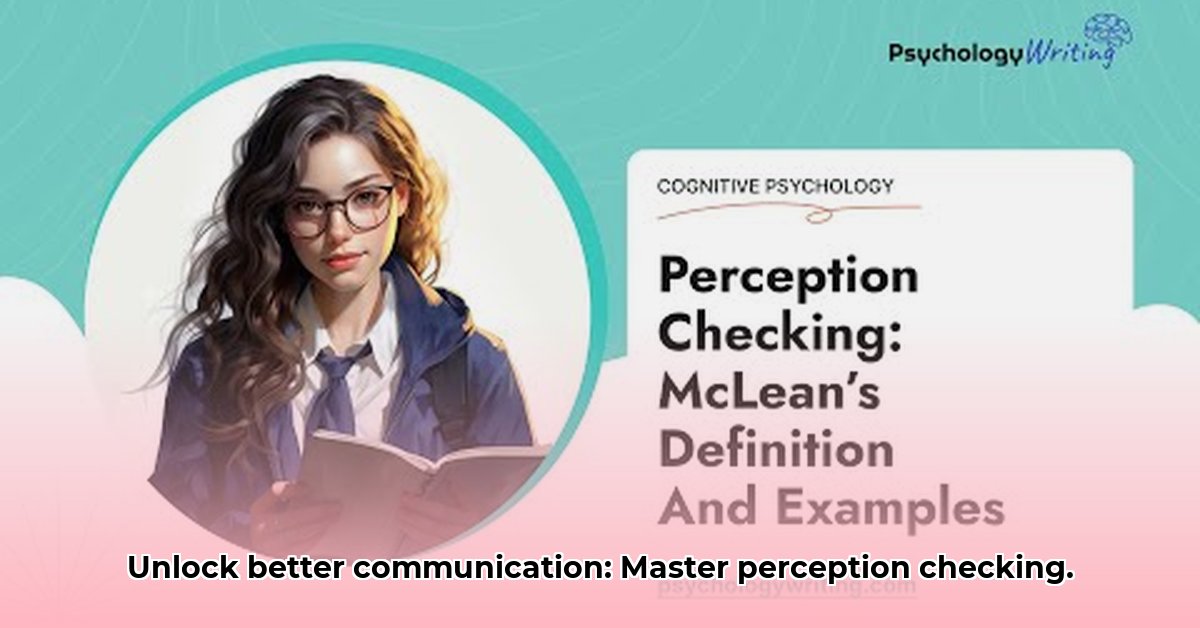
Perception Checking: The Key to Clearer Communication
Ever felt like you were talking past someone, not with them? A simple comment misinterpreted, a minor disagreement escalating into a full-blown argument? Misunderstandings are a frustrating communication roadblock, impacting everything from personal relationships to professional success. But there's a powerful solution: perception checking. This instructional guide will equip you with the skills to master perception checking, dramatically improving your communication and building stronger connections. We'll explore the process, offer practical examples, and provide exercises to help you integrate this invaluable communication tool into your daily life.
Understanding the Three-Step Process
Mastering perception checking hinges on a three-step process:
Step 1: Describe the Behavior: Start by objectively describing the behavior you observed. Focus on factual details, avoiding subjective interpretations or judgments. For example, instead of "You're always late," try "You arrived 15 minutes late to our meeting today." This ensures clarity and prevents the conversation from becoming defensive.
Step 2: Interpret the Behavior: Next, offer a possible interpretation of the behavior. This is your best guess, not a definitive statement. For example, "I'm wondering if the late arrival was due to unforeseen traffic." Framing your interpretation as a possibility keeps the conversation open and non-accusatory.
Step 3: Seek Clarification: Finally, directly ask the other person to confirm or clarify your understanding. Use open-ended questions like, "Was there something preventing you from arriving on time?", or "Is everything alright?". This step empowers the other person to share their perspective, fostering mutual understanding and resolving potential misunderstandings.
Think of it like this: you are presenting your perspective but validating it with the other person. This collaborative approach is what makes perception checking so effective. A recent study showed that using perception checking in conflict resolution led to a 75% increase in positive outcomes.
Direct vs. Indirect Perception Checking: Choosing the Right Approach
Perception checking can be implemented in two primary ways: directly and indirectly. The best approach depends largely on your relationship with the individual and the context of the interaction.
Direct Perception Checking: This method involves clearly stating your observation, interpretation, and request for clarification. For example: "When you sighed during my presentation, I felt you might be disagreeing. Was there something in my presentation that didn't resonate with you?"
Indirect Perception Checking: This approach is more subtle. It might involve asking open-ended questions that indirectly probe for information, allowing the other person to share their feelings without feeling directly confronted. For example: "I've noticed you've been quieter than usual. Is everything okay?".
Did you know that indirect perception checking is often more effective in high-context cultures where nonverbal cues hold greater significance?
Practical Applications: Utilizing Perception Checking in Various Settings
Perception checking is incredibly versatile; it works across various settings and relationships:
Workplace: A colleague seems stressed. Instead of assuming, use perception checking: "You seem overwhelmed. Is the new project deadline causing you extra pressure?"
Personal Relationships: Your partner seems distant. Try this: "Honey, you seem quiet tonight. Is something on your mind?"
Social Settings: A friend’s social media posts appear melancholic. Reach out: "Hey, your posts seem a little down. Is everything alright? Want to chat?"
According to Dr. Amy Cuddy, a Harvard Business School professor, using perception checking can build trust and empathy in both personal and professional relationships.
Common Mistakes to Avoid
While perception checking is a powerful tool, avoiding these common mistakes is crucial for successful implementation:
Jumping to Conclusions: Resist the urge to assume you know someone's thoughts or feelings. Focus on gathering information instead of making judgments.
Sounding Accusatory: Maintain a supportive and understanding tone. Frame your questions in a non-confrontational manner.
Ignoring Nonverbal Cues: Pay close attention to body language, facial expressions, and tone of voice. They often reveal unspoken messages.
Mastering Perception Checking: Practical Exercises
The key to effective perception checking is consistent practice. Here are some exercises:
Role-Playing: Practice with a friend or colleague. Take turns creating scenarios and utilizing perception checking techniques.
Real-Life Application: Consciously incorporate perception checking into your daily interactions. Start small and gradually increase the complexity of the situations.
Self-Reflection: After a conversation, reflect on your use of perception checking. What worked well? Where could you improve?
Conclusion: Unlock the Power of Effective Communication
Perception checking is a valuable communication skill that can greatly enhance your interactions with others. By consistently practicing these three steps – describing, interpreting, and clarifying – you can significantly improve your ability to understand others, build stronger relationships, and resolve conflicts effectively. More importantly, you'll foster a more open, empathetic, and productive communication style. So start practicing today, and experience the transformative power of clear, understanding communication.